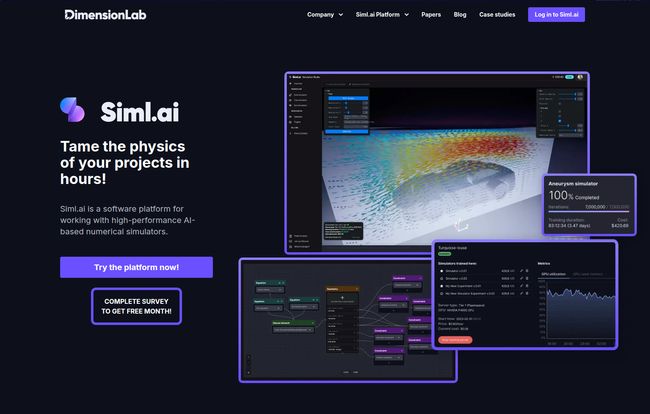I’ve been in the SEO and tech space for years, and every so often, a tool pops up that makes you lean forward in your chair a little. You know the feeling. It’s that little spark of, “Huh, that’s… different.” For me, that recently happened with a platform called Siml.ai.
Let’s be real for a second. Traditional physics simulation is a beast. Anyone who’s ever tried to run a complex fluid dynamics or thermal analysis knows the pain. You’re usually chained to a monstrously expensive software license, tethered to a workstation with more power than a small data center, and then you wait. And wait. And… wait some more, all for a single simulation run. It’s powerful stuff, but man, it's not exactly what you’d call agile.
So when I saw Siml.ai’s tagline about “AI-driven physics simulators... in real-time,” my curiosity was officially piqued. A no-code, web-based platform that promises to slash simulation times? It sounds almost too good to be true. So, I did what any self-respecting tech nerd would do: I dove in to see if it’s genuinely revolutionary or just another flash in the pan.
So, What Exactly is Siml.ai?
At its heart, Siml.ai is a platform that mashes together machine learning with hard physics. Instead of solving complex differential equations from scratch every single time you run a simulation (the traditional, slow way), it allows you to train an AI model on existing simulation data or real-world experimental data. Once trained, this AI becomes a sort of hyper-fast predictive engine—a physics simulator that can give you results almost instantly.
Think of it like this: Traditional simulation is like a master chef carefully following a complex recipe from scratch every time you order a dish. Siml.ai is like training another master chef by having them watch the first one thousands of times, until they can replicate the final dish in seconds, just by glancing at the ingredients. It’s an approximation, sure, but it’s an incredibly fast and often very accurate one.
The entire thing is split into two main components, which makes a lot of sense when you think about the workflow.
Model Engineer: The AI's Training Ground
This is where you build your brain. Model Engineer is the web-based application where you feed the machine. You take your datasets—from old simulations on platforms like COMSOL or ANSYS, or even from physical sensors—and use them to train a neural network. It's designed to be a no-code experience, which is a massive plus. You can visually design your AI architecture, manage your data, and kick off the training process on their high-performance computing infrastructure without writing a single line of Tensorflow or PyTorch. It’s the digital gym where your AI gets smart.
Simulation Studio: Where the Magic Happens
Once your AI model is trained and ready, you bring it into the Simulation Studio. This is the fun part. This is where you actually use the simulator you’ve created. You can set up new scenarios, tweak parameters on the fly, and see the results update in real-time. This is where the promise of creating interactive “digital twins” comes to life. Because the AI model is so fast, you can explore a problem’s design space in a way that was previously impossible. They even boast some slick Unreal Engine rendering for visualizations that don’t look like they came from a 1990s textbook. A nice touch.

Visit Siml.ai
What Actually Gets Me Excited About This
Okay, let's get down to the brass tacks. Why do I think this is more than just a gimmick? A few things really stand out.
First, the speed is just bonkers. The claim of being 85%+ faster isn't just marketing fluff; for certain problems, AI-based prediction can be orders of magnitude faster than conventional solvers. This changes the game from a slow, deliberate process to an interactive, creative one. You can ask “what if” a dozen times in an afternoon, not once a week.
Second, being fully web-based is a bigger deal than it sounds. No installs. No license servers. No needing a specific operating system. You and your colleague on a Mac can collaborate with a partner on a Windows machine without any friction. It truly democratizes access. I can run this from my laptop at a coffee shop (and I have). That’s just not something you can say about most traditional engineering software.
And finally, the painless scalability. Siml.ai handles all the backend infrastructure. You don't need to be a cloud computing wizard to tap into powerful GPUs for your AI training. You just select what you need, and the platform takes care of the rest. This removes a huge barrier to entry for smaller companies, researchers, or even individuals who don't have an IT department to manage a computing cluster for them.
Keeping It Real: The Potential Hurdles
Now, I wouldn’t be doing my job if I didn’t talk about the other side of the coin. No tool is perfect, and Siml.ai is no exception. It’s important to go in with your eyes open.
The biggest challenge, and this is true for any AI/ML application, is the old adage: garbage in, garbage out. The predictive power of your AI simulator is completely dependent on the quality and breadth of the data you train it on. If your training data is sparse or inaccurate, your AI model will be, too. It’s not magic; it’s a pattern-matching machine.
Also, while it's a “no-code” platform, creating a truly optimal model still requires a solid understanding of both the underlying physics and the basics of machine learning. You need to know what you’re looking at to build an effective AI. It lowers the barrier to entry, it dosn't eliminate the need for expertise. This is a tool to empower engineers and scientists, not replace them.
A Look at the Siml.ai Pricing Tiers
Price is always a major factor, so let's break down their plans. They offer a pretty logical spread, from a free tier to a full-blown enterprise solution. It’s nice to see a company that lets you genuinely try before you buy.
| Plan | Price | Key Features | Who It's For |
|---|---|---|---|
| ALWAYS FREE | Free | Up to 3 public simulators, limited Tier 1 computing. | Students, hobbyists, or anyone wanting to kick the tires. |
| STARTER | €199 / month | 50GB storage, Tier 2 computing, up to 10 simulators. | Individual professionals or small startups getting serious. |
| STANDARD | €499 / month | 250GB storage, Tier 4 computing, up to 20 simulators. | The sweet spot for most research teams and SMEs. |
| PRO | €999 / month | 1TB storage, Tier 6 computing, unlimited simulators. | Power users and larger organizations with heavy simulation needs. |
| ENTERPRISE | Custom | All Pro features, custom GPU resources, 24/7 support. | Large corporations or research institutions with specific, demanding requirements. |
A cool thing to note is that all paid plans come with a 14-day trial. They also seem to be pushing their Discord community pretty hard, offering a free month for early adopters who fill out a survey. That’s a smart way to build a user base and get valuable feedback.
Frequently Asked Questions about Siml.ai
- Is Siml.ai really 'no-code'?
- Yes, in the sense that you can build, train, and run simulators without writing programming code. However, to get high-quality, reliable results, you still need domain expertise in the physics of your problem and a basic understanding of what makes a good training dataset for an AI model.
- What kind of problems can I solve with Siml.ai?
- The applications are pretty broad, spanning anywhere traditional physics simulation is used. Think computational fluid dynamics (CFD), heat transfer, structural mechanics, acoustics, and more. If you can generate data for it, you can likely train a simulator for it.
- Do I need a supercomputer to use Siml.ai?
- Absolutely not! That's one of its main advantages. Because it’s web-based, all the heavy computational lifting is done on their cloud servers. You can access and run everything from a standard laptop or desktop with an internet connection.
- How does this compare to something like ANSYS or COMSOL?
- It's a different tool for a different job. Think of ANSYS/COMSOL as the foundational, high-fidelity solvers. You might still use them to generate the initial, highly accurate data. Siml.ai then takes that data and creates a lightning-fast simulator for rapid iteration and design exploration. They're complementary—one for ground-truth accuracy, the other for interactive speed.
- Is there a community or support available?
- Yes, they have a growing Discord server which seems to be the main hub for their community. This is a great place for users to ask questions, share results, and get help from both the community and the Siml.ai team directly.
Final Thoughts: Is Siml.ai the Future?
After spending some time with it, I'm genuinely optimistic. Siml.ai isn't going to replace traditional physics solvers overnight. But it doesn't have to. What it does is carve out a fascinating and incredibly valuable new niche: the world of real-time, interactive simulation.
It represents a shift, making high-performance simulation more accessible, more intuitive, and frankly, more fun to use. For engineers, designers, and scientists who need to iterate quickly and explore a wide range of possibilities, Siml.ai could be a massive force multiplier. It’s a powerful tool that, in the right hands, could definitely help shape the future of R&D. And I, for one, am excited to see where it goes.



